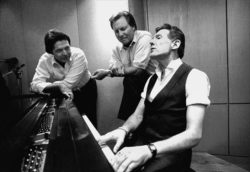Rockabilly
Rockabilly is a genre of music that derived from early rock 'n' roll, with a country-music flavor.

Christopher Harris
Jerry Lee Lewis, Mickey Gilley, and Jimmy Swaggart, 2006. Christopher Harris, photographer.
Rockabilly music is a first-generation rock ‘n’ roll genre that features a driving beat, a wild approach to vocals and instrumental soloing alike, spare instrumentation, and a strong country-music flavor. This latter trait explains the name, a compound word combining “rock” and “hillbilly.” The term “hillbilly” bears none of its potential connotations as an elitist, socioeconomic slur in this context; if anything, it implies pride, since twangy regional accents are emphasized rather than discouraged. In another note on nomenclature, “rockabilly” is sometimes used interchangeably with the terms “rock” and “rock ’n’ roll.” Finally, a great rhythmic similarity exists between rockabilly, western swing, and Cajun two-step.
The rockabilly style was evident on early records by Elvis Presley, released in 1954. These included a cover of Arthur Crudup’s 1940s blues song “That’s Alright Mama” and an up-tempo version of bluegrass artist Bill Monroe’s “Blue Moon of Kentucky.”One of the first major venues where Presley performed such material was the Louisiana Hayride radio show, broadcast out of Shreveport. The same rowdy rockabilly spirit imbued the work of Jerry Lee Lewis of Ferriday, in Concordia Parish, as heard on his 1957 hits “Great Balls of Fire” and “Whole Lotta Shaking Going On.” These records demonstrate the less-is-more approach of rockabilly, eschewing strings, horns, and any other effects that cannot be produced by a small band in live performance, as opposed to recording-studio contrivances.
Lewis is but one of many great first-generation rockabilly musicians from Louisiana. Working out of Shreveport, Dale Hawkins scored a hit in 1957 with “Suzie Q,” which was successfully re-recorded in the 1960s by Creedence Clearwater Revival. Hawkins’ version featured an instantly identifiable guitar solo by James Burton. Burton’s solos with Ricky Nelson a few years later—and with subsequent artists including Emmylou Harris and Elvis Presley in the 1970s—maintained a distinct rockabilly tinge in their electrification of country music finger-picking. As of this writing, Burton continues to play in peak form. In another Louisiana connection, Shreveport-born drummer D.J. Fontana played on Presley’s pioneering rockabilly sides. When the rockabilly fad subsided, Fontana went on to a career as a country music studio musician in Nashville.
In New Orleans, a singing drummer named Joe Clay, who filled in on drums for Presley on occasion, made some great, if little known, rockabilly records in the mid-1950s.These included “You Look That Good to Me,” “Cracker Jack,” “Sixteen Chicks,” “Ducktails,” and “Did You Mean, Jellybean? What You Said, Cabbage Head.” As of this writing, Clay remains active and is in peak form. Another great New Orleans artist who sometimes worked sang in a rockabilly style was Jerry Byrne, whose “Lights Out” was a regional hit in 1958.
Rockabilly also flourished in many other parts of Louisiana. Singer Jay Nelson was renowned for his spirited rockabilly performances in Jeanerette, Morgan City, and environs. In Crowley, J. D. Miller’s recording studio was a 1950s and 1960s hotbed of rockabilly activity for rambunctious artists such as Johnny Jano and Al Ferrier. In Church Point, the small Lanor label released the Cajun rockabilly tune “Parlez-Vous L’Francais” by Bill Matte in 1961. The Lafayette–based Cajun accordionist Aldus Roger—who usually sang in French—recorded a striking rendition of “One Scotch, One Bourbon, One Beer” in 1962. Rusty and Doug Kershaw, from Cameron Parish, recorded several Cajun-themed songs such as “Diggy Liggy Lo,” in 1961, which could be considered rockabilly.
In Lake Charles, Goldband Records put out a series of rowdy, raucous numbers by Cleveland Crochet, most notably the perennial 1960 hit “Sugar Bee” that could also fit into rockabilly’s somewhat loosely defined parameters. Another rockabilly-tinged highlight from Goldband was the anti-Castro song “Castro Rock,” recorded by Jay Chevalier. Recording for a variety of other companies, Chevalier also cut several Louisiana-themed rockabilly originals, including “Billy Cannon”—a tribute to a Louisiana State University football star—and “The Ballad of Earl K. Long,” both released in 1959. Chevalier had worked in Long’s last gubernatorial campaign as an entertainer, warming up the crowds at rallies before Long’s speeches.
Although the style grew somewhat passé by the mid-1960s, such national trends are often meaningless in Louisiana, where rockabilly remains vital as of this writing. In Monroe, guitarist and pianist Kenny Bill Stinson carries the flame with equal parts expertise and passion. In New Orleans, the same applies to Jay Beninati, the fleet-fingered guitarist of Johnny J. and the Hitmen. Guitarist Michael Hurtt and His Haunted Hearts, also based in New Orleans, reflect an encyclopedic knowledge of the genre, as heard when they accompany Jay Chevalier. Ferriday guitarist Gray Montgomery, who once hired Jerry Lee Lewis as his drummer, remains a rockabilly master.
